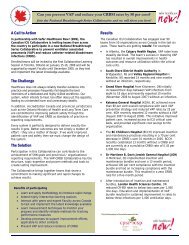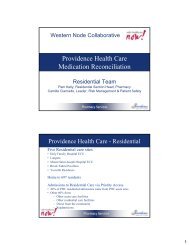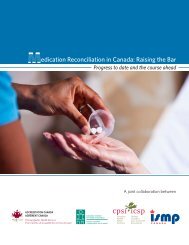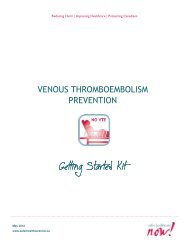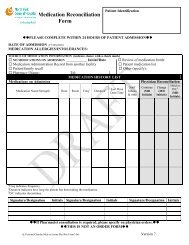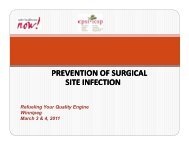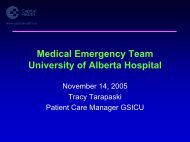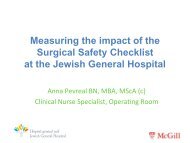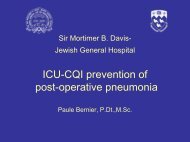VAP Getting Started Kit - Safer Healthcare Now!
VAP Getting Started Kit - Safer Healthcare Now!
VAP Getting Started Kit - Safer Healthcare Now!
You also want an ePaper? Increase the reach of your titles
YUMPU automatically turns print PDFs into web optimized ePapers that Google loves.
<strong>Safer</strong> <strong>Healthcare</strong> <strong>Now</strong>! Prevent Ventilator Associated Pneumonia <strong>Getting</strong> <strong>Started</strong> <strong>Kit</strong><br />
• Utilizing ETTs with SSD in all patients intubated in the emergency department. These<br />
patients are likely to be intubated for longer periods of time. This can be facilitated as<br />
follows.<br />
o Discussion with emergency department physicians to emphasize the importance of<br />
these ETTs.<br />
o Stocking the emergency department with only ETTs with SSD.<br />
o Since ETTs with SSD are slightly larger than tubes without SSD, standard ETTs<br />
should be stocked in the difficult airway cart or tray.<br />
• Utilizing ETTs with SSD in all patients intubated on the medical wards or the in the<br />
Intensive Care Unit. This can be facilitated as follows.<br />
o Discussion with all the ICU attendings, physicians who respond to cardiac arrests,<br />
physicians who are likely to intubabe patients on general hospital wards and<br />
physicians who may be part of medical response teams.<br />
o Stocking airway trays, cardiac arrest carts or intubation kits with only ETTs with<br />
SSD<br />
o Stocking standard ETTs only in difficult airway carts.<br />
• Utilizing ETTs with SSD in high risk patients coming from the operating room. This can be<br />
facilitated as follows.<br />
o Discussion with anaesthetists, anaesthesia housestaff (if any) and respiratory<br />
therapists working in the operating room.<br />
o Make it standard operating procedure that any patient who may require ICU post<br />
operatively will be intubated with an ETT with SSD in the operating room.<br />
• All patients intubated in the ICU for more than 24 hours with standard ETTs should be<br />
reviewed. The review would examine the implementation process for SSD failed and<br />
feedback provided to the clinicians involved in the original intubation. It should be<br />
recognized that some patients may not be candidates for these tubes and the review<br />
should take this into consideration. Patients who may not be candidates for ETTs with<br />
SSD or who may not have received these tubes appropriately.<br />
o Patients who are nasally intubated.<br />
o Patients in whom there was difficulty with the intubation process.<br />
o Patients from OR who were not expected to require ICU care but due to<br />
difficulties intra-operatively come to require post-operative mechanical<br />
ventilation.<br />
• Post the rates of utilization of ETTs with SSD in patients who are mechanically ventilated.<br />
4. Oral care and Decontamination with Chlorhexidine<br />
Oropharyngeal colonization as well as colonization of dental plaque have been identified as risk<br />
factors for <strong>VAP</strong> as there is high concordance between the bacteria isolated from the<br />
oropharyngeal cavity or the dental plaque and those recovered from tracheal aspirates. 93,94<br />
June 2012 22



